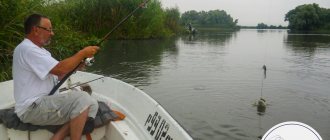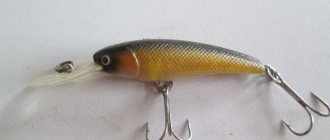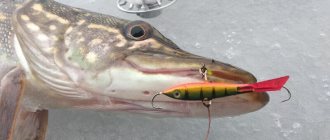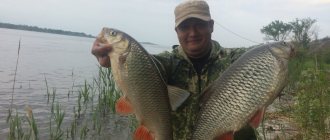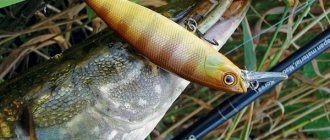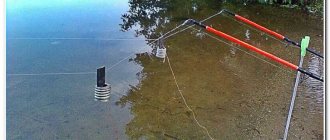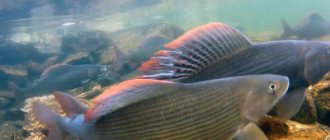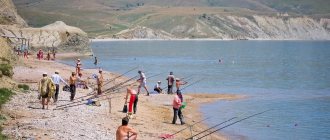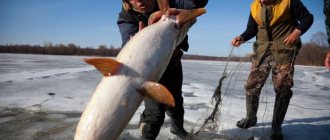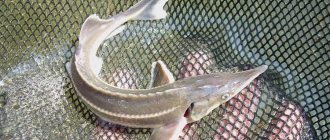Fishing in quarries. Practical advice
( 4 votes, average rating: 5 out of 5)
Loading...
So, you are going to the quarry in search of good fish. And first of all, before going to an unknown body of water, where, according to friends, the fish literally throws itself on the hook, you should find out where, when and in what place such an anomalous biting intensity was noticed. The fact is that the specifics of choosing a quarry for successful fishing directly depend on the following factors.
Catching quarry pike
The long-awaited weekend was approaching, and I decided to devote it to fishing with a spinning rod on infrequently visited quarry lakes 50 kilometers from home. I deliberately arrived at the place in the evening in order to examine the lakes along the perimeter, and at dawn to begin full-fledged fishing. But, having met a local huntsman, I found out that the necklace of lakes consists of seven rather large reservoirs. To find “walking” perches or pike out hunting and catch them, you will have to explore a large area of water almost at random.
The prospect, frankly speaking, was not encouraging, and I decided to try to find some of the local fishermen, simultaneously exploring the quarries with test casts of a spinning rod. As a result, fishing began not in the morning, as originally planned, but right in the evening.
Having missed the rod until dark, I did not see a single bite and did not meet a single angler. Sitting by the fire, I thought and tried to find at least some solution. Fishing is not easy, you will have to come up with something to seduce the predator. I drew some conclusions from the evening lack of bite.
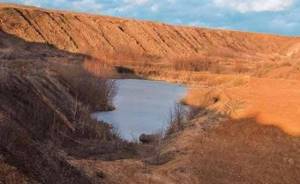
Firstly, the use of a classic jig and an alternative “Cheburashka” with a double hook did not give results due to the bottom vegetation, which collected on the jig head at the very first “steps”. It would be naive to hope that a fish will be tempted by a bunch of black-green grass.
Secondly, wiring various pieces of hardware halfway and above also did not produce results, but only collected debris floating in the water.
Thirdly, the wobblers remained unnoticed by potential hunters, although after wiring they remained “clean”, and, according to my calculations, wiring was carried out specifically over bottom vegetation. Even the well-proven SSR-7 and SSR-9 Rapala plied the waters of the quarries in vain.
Morning perches
When the first rays of the sun touched the tops of the coastal trees, I was already “lashing” the water surface with might and main, having one striped “tail” to my name. Of course, not a lot, but still better than nothing. Night thoughts prompted the idea to use the “Carolina” equipment (Fig. 1).

But the perch did not show itself until I replaced the leash with a regular piece of fishing line with a diameter of 0.18 mm, risking losing the bait due to pike teeth, and installed a smaller offset hook No. 2. The twister began to sink much more slowly, hanging in the water column .
Light twitches of the rod set the bait in motion, tempting predators. And the “Carolina” rig, even when it sank to the bottom, hardly caught aquatic vegetation and did not drag it along with it, which could scare away the fish. At dawn I managed to catch another small “sailor”, and that’s where the “success” stopped. This was strange, because perch always stay in schools, and after catching the first “striped” one, I was counting on a good continuation.
Time passed, but the secret remained unsolved.
Local approach
After some time, a kilometer away from me, I saw through binoculars a fisherman, apparently a local one. I immediately went to him, hoping to get an answer to my question. When I got to the fisherman, a good dozen perches, 400–500 g each, were splashing around in his cage. They were very brightly colored, which indicated that in this place there was a lot of algae at the bottom. The fisherman's gear consisted of a powerful fiberglass rod 5–6 m long, a large float and a small live bait about 20–30 g.
After a conversation with a colleague “for life” and finding out some “professional” subtleties, I found out that in addition to the previously mentioned predators, the reservoirs are rich in “white” fish, mainly roach. You can often find carp that came here from the first quarry, where it has recently been bred. As the fisherman explained, the predator here is caught only with live bait, small perch or roach, usually with a long telescopic rod with a float or with mugs, which is less common, since this requires a boat.
Various types of artificial bait are simply ignored by pike and perch, since the quarries are full of natural food. Well, I think I got it! There is fish, but try to take it, but I didn’t want to leave without a catch. I decided to re-equip the spinning rod, depicting some kind of match rod for long casting, fortunately I always have a float with a set of sinkers and monofilament line for a leash in my kit. For the nozzle I used a small ball rolled from white bread.
Indeed, there was an abundance of small roach, so there was no need to make long casts. There was a bite, and the first potential “bait” ended up on the shore. Having caught a few more small fish, I returned the spinning tackle to its original form, so that I could again catch a predator with it.
I couldn’t fish with live bait with a large float, firstly, because there was no float, and secondly, the test rod was too small. Therefore, I decided to modernize the “Carolina” equipment by putting not a whole live bait on the hook, but a strip of fillet from a fish.
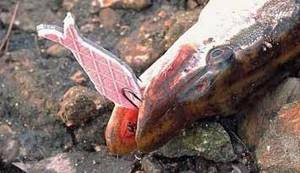
Neither the first nor subsequent casts provoked a single worthwhile attack from predators. There was, however, one “blank blow” that knocked down a strip of roach. Judging by the fact that the bait collected tufts of grass on itself, it was below the permissible level. The buoyancy of the bait during slow retrieval did not meet the requirements, and most importantly, it did not interest the object of fishing, despite its naturalness. I couldn't understand the situation and it was unpleasant.
Solution
What to do in this case? If predators react to artificial baits, it means that they are quite active and their attention is attracted mainly by the strong vibrations and turbulence created by the spoons. When pike or perch are passive, such attacks occur much less frequently or stop altogether.
But I don’t remember almost a single case where “hunters” refused live bait offered to them. When fishing for pike with mugs, I was convinced of this many times. Their belly was simply filled with fry, but the robbers continued to attack the next victim. This suggests that the “live bait” emits vibrations and smells that provoke predators to attack. In my case, everything was fine with the smell, but there were no necessary vibrations. Of course, situations when a pike takes a dead fish are no exception, but I believe that such facts are due to the scarcity of the natural food supply or the increased activity of the predator.
It turned out that for a given reservoir, the ideal bait should move above the bottom above the grass, create vibrations like a natural fish, and smell like a natural fish. I came to the conclusion that approximately these requirements can be met by a side-lead rig used for trolling (Fig. 2).
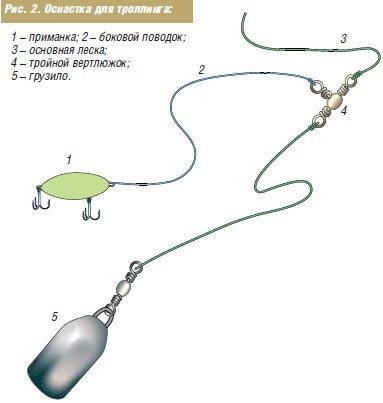
In the field, I couldn’t find anything better than cutting an artificial fish out of the polyurethane mat I was sitting on. I pressed it between the “mustaches” of a double hook, and the result was quite an interesting bait.
Design and modification of the bait
I didn’t have a triple swivel, so my system turned out to be somewhat complicated (Fig. 3).

I tied a carabiner to the main cord, to which I attached a leash made of monofilament with a diameter of 0.18 mm, and to the other end of the leash I attached a “Cheburashka” sinker without a double hook, so that the equipment would collect less debris. Next, I tied a leash from the same cord as the main one to the carabiner, and to it - a tungsten leash to protect against sharp pike teeth. The leash connecting the carabiner to the Cheburashka must be no more than 50 cm long and be at least 20 cm shorter than the leash from the carabiner to the bait.
The fact is that the sinker moves under the surface, which has depressions, edges, and hills. Therefore, as soon as the load goes up the hill, it will approach the bait. And if the fishing line with the “Cheburashka” is longer, then overlap is almost inevitable. In addition, the monofilament leader should have a lower breaking load than other parts. If the sinker gets caught on some obstacle, only that will come off, thereby saving other elements of the equipment.
The sensitivity of such equipment is not bad, since the main fishing line and the “braided” leash transmit the slightest touch of a predator to the bait.
The problem of natural odor was solved very simply. Having ripped open the belly of a previously caught roach, I simply rubbed the artificial fish with the insides of the real one. I would like to pay special attention to the design of the bait made from a polyurethane mat. When clamping it in a double hook, remember that, obeying the laws of physics, the bait will move downward with the hooks. Therefore, when making it and painting the back, take this point into account.
The main flaw in my design was that the bait was unloaded, which became clear on the very first cast, although if I had been a little more careful, I would have realized this at the manufacturing stage. The fact is that the ultra-high buoyancy of the fish made from a polyurethane mat forced it to stand perpendicular to the bottom, and that’s how it moved. Only very fast wiring gave it a more horizontal position, and speed in this case was unacceptable. I had to correct the error. It was not possible to immediately obtain a truly working specimen, but experimentally I found out that the game of the bait most closely matches the game of a live fish only if the weight is placed in the head part (Fig. 4).
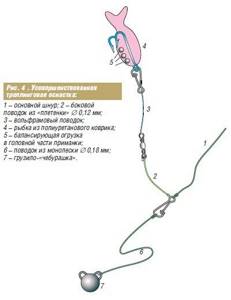
I selected the mass experimentally, but the point was that the buoyancy of the fish was slightly below neutral. As a weight I used several of the heaviest (1.5 g) sinkers for a float rod. Having carefully made a cut along the bait, after laying the ballast, I also carefully sewed it up with ordinary thread. By the way, at home this procedure is much more practical and reliable to do with the help of special glue or paper clips for a construction stapler.
Wiring technique
The wiring technique for such equipment is simple and in some ways similar to the wiring of “Carolina” equipment. It is more convenient for such fishing to use a spinning rod with a length of more than 3 m. A cast is made, two or three turns of the reel, then a pause follows.
After the Cheburashka touches the bottom, you need to wait another 4–5 seconds. At this time, the upturned bait begins seductively, swaying a little, and slowly glides with its nose down.
As practice has shown, it is at this stage of the retrieve that bites occur; such movements most accurately copy a tired or wounded fish. Then, without using a reel, we make one or two short strokes of the rod and pause again, about 3-4 seconds; in between, we choose a free line, trying to control the sinker at the bottom.
There is a slight subtlety here. We must not forget that we are not fishing with a jig, but with an artificial fish, using a side leash. Accordingly, in order to make the most intimate contact with the bait, you need to constantly, very slowly (one revolution every 4-6 seconds), reel in, otherwise the funny thing that happened to me is possible. Starting the next “step”, I discovered that a small bee-eater was already sitting on the hook. He immediately hooked and calmly brought out the prey, but it could have been otherwise.

I suspect that I missed a considerable part of the bites. Evidence of this was an empty double hook once reeled in without bait, apparently knocked down by a predator. Having repeated a series of controlled strokes two or three times, I make the next “step”. The fishing is peculiar and not very active.
Local fishermen, who occasionally met at the reservoirs, looked at me strangely, probably considered me a klutz. And when they saw with their own eyes how I fished for a 2 kg pike, and there was something else in the canvas bag, they were very surprised.
I have an opinion
This method of fishing and the behavior of polyurethane bait have been tested and studied by me using the example of a reservoir with standing water and bottom vegetation. I don’t dare say how it will look on rivers with a current, since I haven’t tested it in practice, but I think that this method would be good for trolling. Perhaps a slightly different load would be required, and it makes sense to lengthen the leashes. In general, a certain field for experimentation has emerged.
I think that wobblers with neutral buoyancy can be an excellent alternative to my bait. But when using them, you need to know the depth of the reservoir or the specific place where you are going to fish. And choosing the right wobbler with a load at a certain depth is not such a big problem.
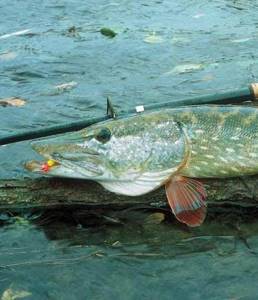
Unfortunately, I didn't have the opportunity to test them. But with floating wobblers, almost the same problem arises as with loading a polyurethane bait.
Their only advantage is that they float up not with their tails, but with their backs up. This gives them, although not obvious, an advantage. Or maybe I was just unlucky with floating wobblers, so I didn’t catch anything with them.
The best replacement or addition, in my opinion, would be the “foam rubber” that has recently become a favorite of many spinning players. The fact is that it has the least difficulty, the material is cheap and easily accessible, and most importantly, it does not require additional loading. When soaked in water, the “foam rubber” with a double hook acquires a density slightly greater than the density of water, and this is exactly the result that is required.
Its behavior in water is almost identical to the behavior of a bait made of a loaded polyurethane mat, and, accordingly, of a natural fish.
I conducted another small experiment with the Mega Strike attractant. Its essence is as follows. At first I fished with “clean” bait, without the use of various bite activators. The result was zero. Then I thickly applied Mega Strike polyurethane. I can’t say that the predator madly began to grab the artificial fish, but there were bites, though most of them were unsuccessful. Apparently, the “hunters” didn’t like something, or maybe I was just yawning them.
But, most importantly, this experiment proved that there is control over even the cunning and well-fed career predator. Of course, the attractant was noticeably inferior to the lubricant from the insides of the roach, but it was also not a complete zero, and this is already good.
Sergey Fedin
Choosing a fishing spot.
Since the depths in the quarries are greater than in most lakes, vegetation and aquatic life appear first in shallower places. Typically this depth starts from 2 meters and ends at 5 meters. Therefore, in order not to look at a stationary float, in the hope that some fish will swim past, you should choose the place for the upcoming fishing much more carefully than when fishing on a river or lake. It is better to spend 1 - 2 hours and walk around the quarry twice, marking several of the most likely, in your opinion, places with the least depth. If you don’t have special equipment (it’s very convenient to break the bottom from the shore with a JJ-Connect Fisherman Wireless 2 echo sounder), focus on underwater streamers that often protrude from under the water. Fishermen also call them “navels.” It is precisely near these very “navels” that the majority of the much-desired fish live.
Fishing in the “Sand Quarries”
Sand quarries Reservoirs of this type are the direct opposite of “toadgrass”: a minimum of grass, a huge volume of water and no reason at all costs to strive to get to the elusive (due to its ultra-transient) pre-freeze-up zhor.
In quarries, we note, something similar also happens - the predator becomes active shortly before ice forms, but this does not last two or three days, but much longer. Or the period of intense biting does not occur in those few days that immediately precede freeze-up, but all the most interesting things happen one and a half to two weeks before, and it is not always possible to guess when it will happen. In general, quarries are reservoirs that are very difficult for fishing, but they attract winter spinners because they are the most “long-lasting” among all “summer” reservoirs—deep quarries retain open water the longest. Let’s say that in your area the average long-term date for the average daily temperature to cross zero is November 4th. "Zhabovniki" usually freeze after a few days - on the eighth or ninth, rivers and reservoirs - on the thirteenth or fifteenth, while the quarries last another week. This is - on average, in reality the winter spinning season in quarries can last another couple of weeks or even more. It happens that you can fish with them for a month after shallow ponds and lakes have “turned off.” If the first wave of cooling completely freezes the “toad trees” (the thickness of the ice reaches ten centimeters), then the subsequent return of heat, as a rule, cannot do anything—the ice will melt a little, but no more. At the same time, the quarries remain open - the ratio of the volume of water to the surface area makes their thermal inertia very high: the energy reserves accumulated by water over six months do not allow the surface layer to cool for a long time. More precisely, the surface layer still cools, but relatively cold water has a high density, so it mixes with the underlying layers that have not had time to cool, and, as a result, the surface of the water in the quarry remains warm for a long time. A typical quarry is a body of water with characteristic dimensions ranging from several hundred meters to a kilometer or even several kilometers in diameter and average depths of five to six meters or more; maximum depths can reach twenty-five to thirty meters. The bottom topography depends on how the reservoir was mined: in “dry” quarries, sand was first excavated, then filled with water; in “wet” quarries, the dredger worked through water, so in “dry” quarries, the bottom was quite even and flat (by bulldozers and dump trucks drove there before the flooding), and the “wet” ones were heavily rugged. Most quarries are located in river floodplains, while some of them have no connection with the river (or only do so during high water), while others - they are often called backwaters - are connected to it by a channel. Fish in isolated and river-connected quarries behave differently, and the differences not least relate to the season in which we are currently interested. Therefore, let's say a few words from the very beginning about how these differences manifest themselves. During the year, a wide variety of fish (bream, asp, pike perch, perch...) migrate between the quarry and the river - if there is a channel between them. Sometimes these migrations are of a regular seasonal nature, that is, they are repeated at approximately the same times, sometimes they depend more on hydrological factors that are not always predictable - the river and the quarry associated with it obey the law of communicating vessels, and the water level in them is always the same. In late autumn, the fish waits for winter. This, among other things, means moving from summer to winter habitats. In search of winter camps, completely sedentary fish migrate, albeit very close. In years with low water in the fall (the water level in October is especially important here), many species of fish look for a winter refuge not in the river, but in a quarry, where the average depth is much greater. This applies not only to those types of fish that generally gravitate to great depths (pike perch, bersh), but also, for example, to perch. As a result, in addition to the fish that constantly live in the quarry, a fair amount of newcomer fish appears in the reservoir from mid-autumn, and the lower the water level in the river-quarry system at this time, the greater the numbers of river fish that enter the quarry. I can’t say that this law works always and everywhere - my observations are limited to ten years and three or four reservoirs of this type, but the results of pre-winter career fishing (not only mine), especially for perch, generally confirm this dependence. In addition, in the pre-freeze-up period in quarries it is often possible to alternately catch perch of two distinct races - the progonist and the humpback. Residential quarry perch weighing 300 g or more are mostly short and thick, while perch that comes from the river usually has an elongated body shape. In quarries cut off from the river, there is, of course, no talk of autumn entry, but in them the average size of perch and pike is, as a rule, larger. Perhaps one is directly related to the other: autumn newcomers pretty much wipe out the food supply of native predators, and in isolated quarries their inhabitants are not threatened by external food competitors. It is significant that I caught my largest perch (weighing almost 2 kg) in just such a sand quarry, which has no connection with the river. True, this was in the summer, but in November an even larger perch was caught in the same reservoir... In general, the fish that is caught in the pre-winter period in sand quarries is quite measured: for perch in the Moscow region it is usually 150-250 g, for pike and pike perch - 1-2 kg, for bersh 300-700 g. My largest career pike weighed more than 6 kg, the largest pike perch - about five. It is important that there are almost no indecently small fish at this time, except that a 200-gram “Mannenholm pike perch” “sticks” to the foam rubber, but this is an exception. The choice of bait is limited to jigs of all types; catching with anything other than jigs at this time and in such a place is extremely problematic. Somehow about twenty years ago (again, for me it was the “pre-jig era”) I caught two pike from a depth of seven meters using a heavy spoon. And one day I saw how, using the same lure, a spinner, who, based on some details of his clothing, was guessed to be an employee of the “authorities,” first caught a perch, and soon a pike. It was just on the day of the police, and therefore there was justice in the success of fishing with a bait that was not the most suitable in place and time... Article on the topic: FISHING FOR CARP AND CRUCCIAN IN SPRING
Advice from experienced people.
This is probably the most important thing that an angler should do when finding himself in an unfamiliar quarry for the first time. It’s worth talking to local fishermen and finding out (if they tell you) what, where and when the fish in the quarry bite best. Don’t hesitate and think that they won’t help you: as they say, a fisherman sees a fisherman from afar.
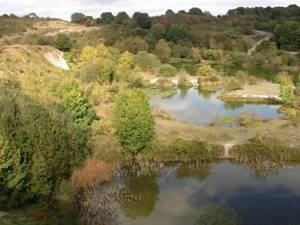
In quarries, the most intense bite is observed in the summer months
Decide what kind of catch you intend to get.
If you are going to catch a bag of trophy fish in early May, then you are heading straight to the store, and not to the quarry. Water that takes a long time to warm up, a large depth of the reservoir, the absence of large schools of fish in one place and a small amount of food at this time of year are a standard phenomenon for most artificial reservoirs in our country. But if you just want to open the official fishing season, and at the same time get new impressions, the quarry is just the right place to set yourself up for a long season.
And not only wobblers
I started my practice of spinning fishing with the so-called classics - oscillating and rotating spoons, which, by the way, caught pike very well in various reservoirs. But with the appearance on the fishing market at that time of new, and today already modern, lures mentioned above, fishing with spoons was relegated to the background, and later I completely forgot about it. But in vain, because the classics are always relevant, especially in such reservoirs. Therefore, in the new season I am going to fish heavily with various spinners, such as, for example, Pontoon21 Sabletta (something between the “Playing” and “Atom” spinners), Sampliora (similar to the then “Senezh” and “Yenisei”), Sintura ( for me, it’s the same “Atom”), Sinuoso Spoon (very reminiscent of the Uralka spinner).
Also here it can be effective to use soft plastic baits of medium size (3-5 inches) in an unloaded/lightly loaded version (more applicable for “toad fishers”). Therefore, you should not forget about “rubber”, although its use will be optional. Still, such a format of a reservoir, in my understanding, is more conducive to fishing with wobblers and spinners.
